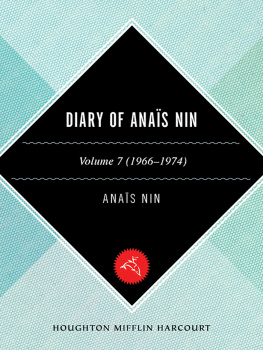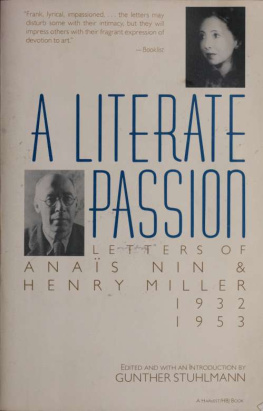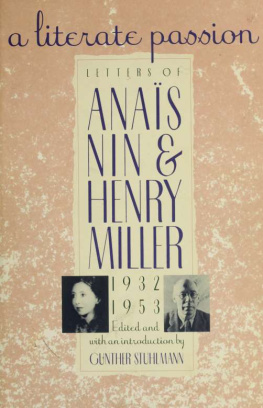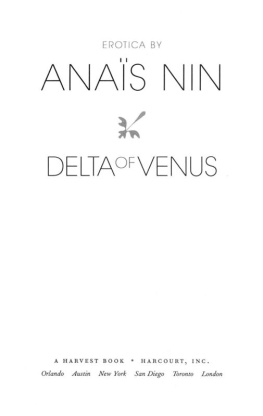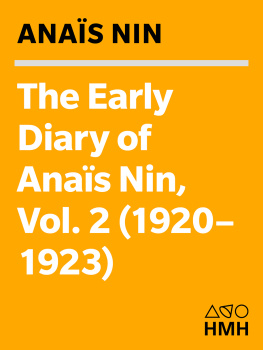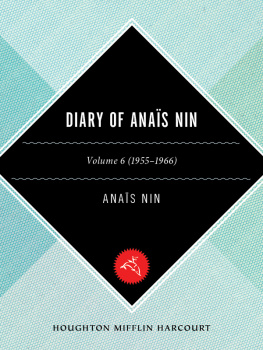Nin Anaïs - The Diary of Anais Nin, Volume 7, 1966-1974
Here you can read online Nin Anaïs - The Diary of Anais Nin, Volume 7, 1966-1974 full text of the book (entire story) in english for free. Download pdf and epub, get meaning, cover and reviews about this ebook. City: New York, year: 1966/1980, publisher: Houghton Mifflin Harcourt, genre: Detective and thriller. Description of the work, (preface) as well as reviews are available. Best literature library LitArk.com created for fans of good reading and offers a wide selection of genres:
Romance novel
Science fiction
Adventure
Detective
Science
History
Home and family
Prose
Art
Politics
Computer
Non-fiction
Religion
Business
Children
Humor
Choose a favorite category and find really read worthwhile books. Enjoy immersion in the world of imagination, feel the emotions of the characters or learn something new for yourself, make an fascinating discovery.
- Book:The Diary of Anais Nin, Volume 7, 1966-1974
- Author:
- Publisher:Houghton Mifflin Harcourt
- Genre:
- Year:1966/1980
- City:New York
- Rating:3 / 5
- Favourites:Add to favourites
- Your mark:
- 60
- 1
- 2
- 3
- 4
- 5
The Diary of Anais Nin, Volume 7, 1966-1974: summary, description and annotation
We offer to read an annotation, description, summary or preface (depends on what the author of the book "The Diary of Anais Nin, Volume 7, 1966-1974" wrote himself). If you haven't found the necessary information about the book — write in the comments, we will try to find it.
The Diary of Anais Nin, Volume 7, 1966-1974 — read online for free the complete book (whole text) full work
Below is the text of the book, divided by pages. System saving the place of the last page read, allows you to conveniently read the book "The Diary of Anais Nin, Volume 7, 1966-1974" online for free, without having to search again every time where you left off. Put a bookmark, and you can go to the page where you finished reading at any time.
Font size:
Interval:
Bookmark:
Copyright 1980 by Rupert Pole as trustee under the Last Will and Testament of Anas Nin
Preface copyright 1980 by Gunther Stuhlmann
All rights reserved.
No part of this publication may be reproduced or transmitted in any form or by any means, electronic or mechanical, including photocopy, recording, or any information storage and retrieval system, without permission in writing from the publisher.
For information about permission to reproduce selections from this book, write to Permissions, Houghton Mifflin Harcourt Publishing Company, 215 Park Avenue South, New York, New York 10003.
www.hmhco.com
The editor and publisher wish to thank the C. G. Jung Foundation for permission to quote from Womans Mysteries, by M. E. Harding, copyright 1971 by the C. G. Jung Foundation for Analytical Psychology; and William Morrow & Company, Inc. for permission to quote from Venture to the Interior, by Laurens van der Post, copyright 1951, 1979 by Laurens van der Post. The Magic Circle Weekend material () was first published by Magic Circle Press in Celebration with Anas Nin, edited by Valerie Harms, copyright 1973 by Valerie Harms.
The Library of Congress has cataloged the print edition as follows:
Nin, Anas, 19031977.
The diary of Anas Nin.
Vol. 3 has imprint:
New York, Harcourt, Brace &
World; v. 47: New York, Harcourt Brace Jovanovich.
CONTENTS: v. 1. 19311934.v. 2. 19341939.v. 3. 19391944.[etc.]v. 7. 19661974.
1. Nin, Anas, 190377Diaries. 2. Authors, American20th centuryBiography. I. Stuhlmann, Gunther, ed. II. Title.
PS 3527. I 865 Z 5 818'.5203 [B] 66-12917
ISBN 0-15-125596-2
e ISBN 978-0-544-47780-3
v1.1114
Anas Nin died in California on January 14, 1977, just a few weeks before her seventy-fourth birthday. The final decade of her life, which to some extent is reflected in these pages, brought many things to the woman who at the age of eleven had embarked upon that long and tireless voyage into the labyrinth of her diary. Today, we have a complete French edition of those early letters to a lost father from her first exile in America, spanning the years 1914 to 1920. With this, the seventh and final volume in the present series, we add another segment to the already published portions drawn from the original diaries, reaching from Anas Nins little-noticed dbut as a published writer and early champion of D. H. Lawrence in Paris at the start of the 1930s, to the agonizing yet obviously inevitable decisiondescribed in Volume VIto open her diary to the world, some thirty-five years later. On a universal scale, this decade produced an intense emotional response to Anas Nins lifework, which led her to exclaim in 1972: How could I have felt so weak and so passive at twenty and feel so strong now? It is so wonderful.
Indeed, the last ten years of Anas Nins life were rich in recognition, acceptance, in realized ambition and, for a time at least, in increased mobility. They were also overshadowed, privately, by the growing intrusion of a cancer that eventually wrestled down her body though it never succeeded in breaking her spirit. With the same stubborn strength she had displayed throughout her life in defense of her own creation, she fought to the very last against the rapacious cells in her body. Confined for most of the last two years to the house in Los Angeles, unable to travel easily, to lecture, she tended with iron devotion to the work that still lay ahead. She oversaw the translation into English of her childhood diaries. She proofed, with waning strength, a selection of the erotic stories she had produced in the early 1940s as a quick way to earn a few dollars from an unpoetic collector but also as an artistic challenge, which only a few months after her death propelled her name for the first time onto the best-seller lists of Europe and of the United Statesan irony she would surely have appreciated. She also kept a book of pain and a book of music by her bedsidethe ingrained diary habit, as she so often had called it, asserting itself to the last. But the original decision to publish portions of her diary did not extend to these final private notes. What Anas Nin wanted to leave with us, and leave us with, at the end of Volume VII, was not a record of pain and suffering but her impressions of a last joyful journey, the realization of an old dream: a glimpse of that magical island, Bali, where for a brief moment the enchanting fairy tales of childhood, of the mysteries of the East, of a fantastic land of golden spires, graceful people and natural abundance, could be rekindled before the onrushing bitter reality. After all, her motto had always been: Proceed from the dream outward.
The publication, in the spring of 1966, of the first volume culled from the mountain of notebooks which had been accumulating in that famous Brooklyn bank vault, as we now know, marked a major turning point in Anas Nins life. The frightening explosion she had envisioned in a dream while struggling with the decision to break the seals of her secret enterprise did indeed take place. But, like the unpredictable flow of the diary itself, the explosion that followed took forms that had been impossible to anticipate.
After the trying years of neglect as an artist, Anas Nin, at the age of sixty-three, suddenly found a vast and receptive readership throughout the world. At a time when the quest for self-realization, for the liberation from outmoded societal impositions, from traditional roles, had gained an almost epidemic momentum, especially among the young, her Diary struck a highly responsive chord. From a solitary underground writer who had shared her work with a small audience, who had occasionally discussed her art with a handful of interested students, she suddenly found herself transported onto the spotlighted stages of giant lecture halls. It was a difficult, if gratifying, transition. Discovered by the media, by political action groups, by militant feminists and by lonely individuals who strongly identified with her own struggles toward liberation, Anas Nin found herself caught up in an ever increasing groundswell of being interviewed, recorded, taped, cheered, crowded by fans, warmed by their intensely personal responses and sometimes badgered and exploited by her newfound admirers.
The private person who had confided to the diary her hunger for recognition, for a response to her lifework so long carried on in secret, almost overnight confronted the pressures of public exposure. Like her old friendsHenry Miller, Lawrence Durrellbefore her, Anas Nin found the satisfaction of a belated triumph overlaid with the consuming demands levied upon a celebrity, especially in the United States. The intimacy with the self, which had given such exemplary strength to the diary and which she had pursued so diligently behind her many veils, was challenged by what was asked of her most often now, that most contradictory, most difficult of all demands: to establish intimacy with the world at large.
While her name appeared emblazoned on T-shirts and (much to her amusement) cropped up in literate crossword puzzles, the work on which this very recognition was founded, the intimate diary, was gradually being transformed into something else. The journalists ask me if I am still writing in the Diary, Anas Nin notes in the spring of 1972. I answered yes automatically, but one day I realized it was not true. The Diary has become a correspondence with the world. Was this what I really wanted?
As Anas Nin expanded into the world at large, the world also invaded her diary. The secret notebook, the hashish and vice of her early days, began to bulge with clippings, interviews, travel articles, prefaces, reviewsa scrapbook of her external achievements. As mountains of letters cried out for a personal response, the laboratory of the soul was opened to the public, I keep the Diary spasmodically, less consistently, she admits early in 1973. I will write a lot when I am traveling or on vacation. The voice of Anas Nin the diarist is still there, unmistakably, but with a decreasing need for secrecy, it is addressed, increasingly, to the world out there. With future readers looking over her shoulder, with friends asking jokingly whether they will be in the diary, the refuge, the clandestine workshop, becomes transformed into an open letter.
Next pageFont size:
Interval:
Bookmark:
Similar books «The Diary of Anais Nin, Volume 7, 1966-1974»
Look at similar books to The Diary of Anais Nin, Volume 7, 1966-1974. We have selected literature similar in name and meaning in the hope of providing readers with more options to find new, interesting, not yet read works.
Discussion, reviews of the book The Diary of Anais Nin, Volume 7, 1966-1974 and just readers' own opinions. Leave your comments, write what you think about the work, its meaning or the main characters. Specify what exactly you liked and what you didn't like, and why you think so.

